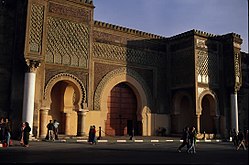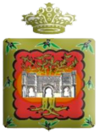Meknes
|
Meknes مكناس / ⴰⵎⴽⵏⴰⵙ / Meknès |
||
|---|---|---|
| Prefecture-level city | ||

Bab Mansour Gate, the historical sign of Meknes.
|
||
|
||
| Nickname(s): العاصمة الاسماعيلية مكناسة الزيتون The Ismaïlian Capital The médina of 100 minarets. |
||
| Location in Morocco | ||
| Coordinates: 33°53′42″N 5°33′17″W / 33.89500°N 5.55472°WCoordinates: 33°53′42″N 5°33′17″W / 33.89500°N 5.55472°W | ||
| Country |
|
|
| Region | Fès-Meknès | |
| Prefecture | Meknès Prefecture | |
| Government | ||
| • Mayor | Abdellah Bouanou | |
| • Prefect | Abdelghani Sebbar | |
| Elevation | 546 m (1,792 ft) | |
| Population (September 2014) | ||
| • Prefecture-level city | 835,695 | |
| • Rank | 6th in Morocco | |
| • Urban | 656,635 | |
| • Metro | 1,000,000 | |
| Time zone | GMT (UTC±00:00) | |
| • Summer (DST) | WEST (UTC+01:00) (UTC) | |
| Postal code | 50000 | |
| Website | www |
|
| Historic City of Meknes | |
|---|---|
| Name as inscribed on the World Heritage List | |
 |
|
| Location | Morocco |
| Type | Cultural |
| Criteria | iv |
| Reference | 793 |
| UNESCO region | North Africa / Arab States |
| Inscription history | |
| Inscription | 1996 (20th Session) |
Meknes (Arabic: مكناس Mknas; Berber: ⴰⵎⴽⵏⴰⵙ, Ameknas ; French: Meknès; Spanish: Mequinez) is one of the four Imperial cities of Morocco, located in northern central Morocco and the sixth largest city by population in the kingdom. Founded in the 11th century by the Almoravids as a military settlement, Meknes became a capital under the reign of Sultan Moulay Ismaïl (1672–1727), the founder of the Alaouite dynasty. Using European slave labour Sultan Moulay Ismaïl turned it into an impressive city in Spanish-Moorish style, surrounded by high walls with great doors, where the harmonious blending of the Islamic and European styles of the 17th century Maghreb are still evident today. The urban population is estimated at more than 650,000 with the metropolitan population close to 1,000,000. It is the seat of Meknès Prefecture and an important economic pole in the region of Fès-Meknès.
Meknes is named after a Berber tribe which, was known as Miknasa (native Berber name: Imeknasen) in the medieval North African documents.
The Almoravids founded a fortress in Meknes during the 11th century. It resisted the Almohads rise, and was thus destroyed by them, only to be rebuilt in a larger size with mosques and large fortifications. Under the Merinids it received further madrasas, kasbahs and mosques in the early 14th century, and continued to thrive under the Wattasid dynasty. Meknes saw its golden age as the imperial capital of Moulay Ismail following his accession to the Sultanate of Morocco (1672–1727). He installed under the old city a large prison to house Christian sailors captured on the sea, and also constructed numerous edifices, gardens, monumental gates, mosques (whence the city's nickname of "City of a Hundred Minarets") and the large line of wall, having a length of 40 kilometres (25 miles). His many building projects were made possible by a large number of European slaves taken at sea. As much as 30 000 slaves were working on his palace every day.
...
Wikipedia


